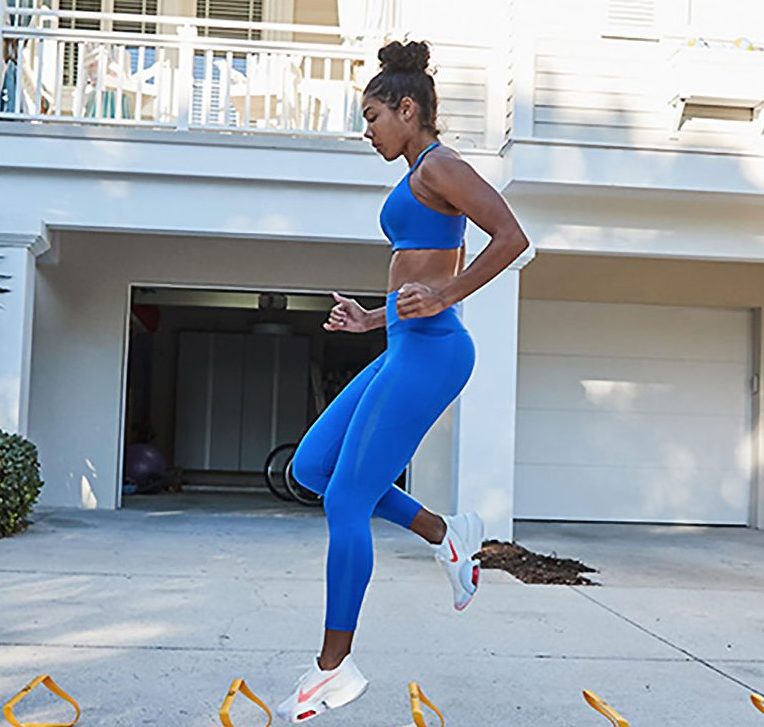Dick’s Sporting Goods significantly hiked its guidance for 2021 as stellar first-quarter results provided more confidence that the surge seen across many categories during the pandemic would continue to pay dividends in the future.
On a conference call with analysts, Lauren Hobart, president and CEO, said team sports “came back with a vengeance” in the first quarter after leagues were widely canceled after the pandemic emerged last year. However, she added that “surging categories” last year, due to changing behaviors as a result of the pandemic, citing golf, home fitness and outdoor, are “still really, really strong.”
She noted that, like many retailers, Dick’s is trying to understand what the “new consumer behavior is going to be” post-pandemic but said her team has become more confident about a sustained benefit.
Said Hobart, “We feel really, really positive about the business and what we’re seeing about consumer demand as we head into the future.”
Ed Stack, executive chairman and chief merchandising officer, added that beyond any pandemic benefit, he believes Dick’s is benefiting from steps taken in recent years to further differentiate its stores “versus our direct competitors and even some tangential competitors.” The steps include adding concept shops from Nike and other major vendors, adding premium full-service footwear areas and investments in building “vertical brands” or private label brands.
“I think that the consumer realizes that, shopping us more, and it gives us the opportunity, from a margin rate standpoint, to not be in that promotional environment,” said Stack. “And when, and if, a promotional environment comes back, I think we’ll be in less of a promotional aspect from our company because of the differentiated product.”
Like many other retailers, Dick’s provided comparisons against the more normalized 2019 period and 2020 in both the latest quarter and in its outlook as the year-ago period was disrupted by temporary store closures with the pandemic’s arrival.

Dick’s updated outlook for 2021 calls for:
- Sales in the range of $10.5 billion to $10.8 billion, representing at the midpoint a gain of 22 percent against 2019 and 11 percent against 2020. Previously, sales were expected to increase 11 percent against 2019 and 2 percent against 2020.
- Same-store sales in the range of 8.0 percent to 11.0 percent. Previously, comps were expected to range between a decline of 2 percent or an increase of 2 percent. The gains come on top of increases of 9.9 percent in 2020 and 3.7 percent in 2019.
- Income before income taxes on a non-GAAP basis in the range of $1.02 billion to $1.1 billion, representing a gain of 142 percent against 2019 and 45 percent against 2020. Previously, income before income taxes was projected in the range of $550 million to $650 million, representing a gain of 36 percent against 2019 and a decline of 18 percent against 2020.
- EPS on a non-GAAP basis to range between $8.00 and $8.70 versus $3.69 in 2019 and $6.12 in 2020. At the mid-point of the range, non-GAAP EPS was expected to grow 120 percent versus 2019 and 29 percent versus 2020. Previously, non-GAAP EPS was expected in the range of $4.40 and $5.20, representing a gain of 30 percent against 2019 and a decline of 22 percent versus 2019.
In the first quarter ended May 1, earnings on a non-GAPP basis reached $367.2 million, or $3.79 per share, more than triple Wall Street’s consensus target of $1.12. Results were well above non-GAPP earnings of $58.4 million, or 62 cents, in the 2019 first quarter.
The latest quarter excluded amortization of the debt discount associated with the company’s convertible senior notes and included the share impact of the convertible note hedge purchased by the company. First-quarter 2019 non-GAAP results exclude non-cash asset impairment and the settlement of a litigation contingency. The year-ago period excludes non-cash asset impairment and the settlement of a litigation contingency.
On a reported basis, net income came to $361.8 million, or $3.41 per share, compared to a net loss of $143.4 million, or $1.71, in the 2020 first quarter and earnings of $57.5 million, or 61 cents, in the 2019 first quarter.
Sales were $2.92 billion, an increase of 119 percent compared to the first quarter of 2020 and 52 percent compared to the first quarter of 2019.
The gains were driven by a 115 percent increase in same-store sales, which included an increase in e-commerce sales of 14 percent. E-commerce sales vaulted 110 percent in last year’s first quarter as stores faced temporary closures, and e-commerce penetration grew from 13 percent of sales in the first quarter of 2019 to 20 percent for the first quarter of 2021. E-commerce penetration reached 39 percent in the 2020 first quarter amid store closures.
First-quarter 2020 same-store sales had declined 29.5 percent, driven by temporary store closures that started on March 18, 2020. First-quarter 2019 consolidated same-store sales were flat.
Brick and mortar stores comped up nearly 190 percent as last year’s temporary store closures were anniversaried. Compared to 2019, brick and mortar comps increased 40 percent on roughly the same square footage.
The 115 percent comp increase was helped by across board growth across categories as hardlines, apparel and footwear comped up over 100 percent year-over-year. Transactions increased 90 percent, and the average ticket advanced 25 percent year-over-year.
Beyond strong demand for its merchandise, Dick’s officials said the sales growth in the latest quarter benefited from government stimulus checks.
Gross margins in the latest quarter reached 37.3 percent of sales, up 2,100 basis points compared to last year and 795 basis points compared to 2019. Approximately 1,000 basis points of the improvement reflected sales leverage. Merchandise margins expanded 787 basis points, primarily driven by fewer promotions and a favorable sales mix. The year-ago period also included $28 million of inventory write-downs resulting from the temporary store closures that were subsequently recovered in the second quarter of 2020 as sales came in better-than-expected as stores reopened. The remaining margin improvement was traced to lower shipping expenses as a percent of sales due to higher brick and mortar store sales penetration.
SG&A expenses reached 20.8 percent of sales and leveraged 940 basis points compared to last year due to the significant sales increase. On a non-GAAP basis, SG&A expenses, as a percent of net sales, leveraged 446 basis points versus the 2019 first quarter.
EBIT on a non-GAAP basis in the latest quarter came to $477.1 million, or 16.4 percent of sales, a quarterly record margin and up 3,200 basis points versus the year-ago period. Compared to the 2019 first quarter, non-GAPP EBIT increased $396 million, or approximately 1,200 basis points as a percent of sales.
Hobart said the quarter represented Dick’s highest-ever quarterly earnings and they significantly exceeded internal expectations.
“The strength of our diverse category portfolio, supply chain technology capabilities and omni channel execution helps us continue to capitalize on strong consumer demand across golf, outdoors activities, home fitness and active lifestyle, said Hobart. “We also saw resurgence in our team sports business as began to get back out on the field after a year in which many sports activities were delayed or canceled.”
Within e-commerce, in-store pickup and curbside continue to expand, increasing 500 percent when compared to the first quarter of 2019. As a percent of sales, in-store/curbside pickup saw sequential growth compared to the second half of last year. The retailer’s more than 900 stores enabled approximately 90 percent of its total sales and fulfilled approximately 70 percent of online sales through either ship-from-store, in-store pickup or curbside.
She also highlighted that earnings benefited from a continued disciplined promotional strategy and cadence as many categories in the marketplace remain supply-constrained.
Updating investors on strategy growth drivers, Hobart said merchants continue to leverage the retailer’s strong national brand partnerships and “highly profitable and growing” vertical brand portfolio to drive differentiation and exclusivity in assortments. Dick’s vertical brands saw triple-digit comp growth in the quarter and achieved merchandise margin rate expansion that outperformed the company average.
DSG, its largest in-house brand, as well as Calia, its second-largest women’s apparel brand, both saw “sustained success” in the period. VRST, its new men’s athleisure range, launched to a “really strong start.” Overall, improved space in-store and increased marketing are planned in support of its vertical brands this year.
At the store level, investments continue to be made in elevating service levels and adding more experiential elements.
“We’re reimagining the athlete experience both across our core business, and through new concepts that we have been working on for the past several years, which will collectively propel our growth in the future,” said Stack on the call.
Stack highlighted that the retailer’s first Dick’s House of Sport in Rochester, NY is “off to a great start and is on track to become among our highest volume store in the chain.” The concept stands out for its outdoor field that can host sports events and promotes product trial as well as elevated in-store shops. A second location is scheduled to open in Knoxville and learnings from the concept will be rolled out to its flagship concept.
Dick’s also plans to introduce its first two Public Lands’ outdoors-themed locations to represent another growth vehicle.
In golf, Stack said the overall category “has been tremendous” for the company and the Golf Galaxy chain has been “significantly outperforming” the company average in recent quarters.
As a result, Dick’s will be investing over $20 million to “transform” its Golf Galaxy stores, including hiring certified PGA and LPGA professionals. Online booking of lessons and club fitting have also been prioritized and the first Golf Galaxy-specific brand campaign has been introduced. Nearly twenty stores have been redesigned with TrackMan technology added to over 80 percent of the chain. Another 18 remodels are set for 2021.
“The new stores we’ve remodeled are showing promising results,” said Stack. ”Looking ahead, we expect golf to have a long runway. And we’re committed to leveraging this momentum for future growth within our business.”
Dick’s also added more than 30 soccer in-store shops inside Dick’s locations that features an expanded selection of licensed jerseys and soccer trial elements. Said Hopart, “We’ve been pleased with the initial results and plans to add additional shops throughout the year.”
Footwear remains a “key pillar” to Dick’s merchandising strategy and another 40 stores were converted to premium, full-service footwear departments during the quarter. Over 50 more stores will be converted by the end of the year, bringing full-service footwear decks to approximately 60 percent of the Dick’s chain.
Regarding omnichannel, Hopart said Dick’s continues to drive significant improvement in the profitability of the e-commerce channel through fewer promotions, leveraging fixed costs and strong customer adoption of in-store and curbside pickup. Improved inventory and reduced wait times are particularly supporting pick-up. During the first quarter, over 90 percent of curbside orders were ready within 15 minutes. Hopart said, “Looking ahead, we continue to expect curbside pickup will remain a meaningful piece of our omnichannel offering as our athlete’s trend toward the service for speed and convenience.”
In marketing, Hopart said Dick’s Scorecard program has more than 20 million active members who drive over 70 percent of sales. The program is also supporting strong retention for the 8.5 million new customers acquired last year as well as the nearly 2 million acquired in the first quarter. The new customers continue to skew younger and more female.
Said Hopart, “In closing, we are a growth company steeped in technology and omnichannel experience with a bold path forward. As we continue to execute against our strategic priorities, we are enthusiastic about our business and confident that our investments will strengthen our leadership position within the marketplace.”
Total inventory decreased 4.0 percent at the end of the first quarter.
Lee Belitsky, CFO, said on the call, “Our strong flow of products supported Q1 sales growth in excess of our expectations. Looking ahead, our inventory is very clean, and we continue to expect a robust product flow. As it relates to supply chain expense, we see elevated costs, which we expect to continue but, thus far, have mitigated this pressure through higher ticket as a result of being less promotional and increasing prices in select categories.”
Belitsky said Dick’s is “very pleased with the start of our second quarter, and are highly encouraged about the rest of the year,” with the optimism reflected in its significantly higher guidance. However, he said Dick’s continues to expect comps to decline in the range of high single to low double digits in the second half as the retailer starts facing significantly-elevated comp gains starting in June as well as due to uncertainty “when consumer behavior will normalize and what the new normal is.”
Photos courtesy Dick’s Sporting Goods
















